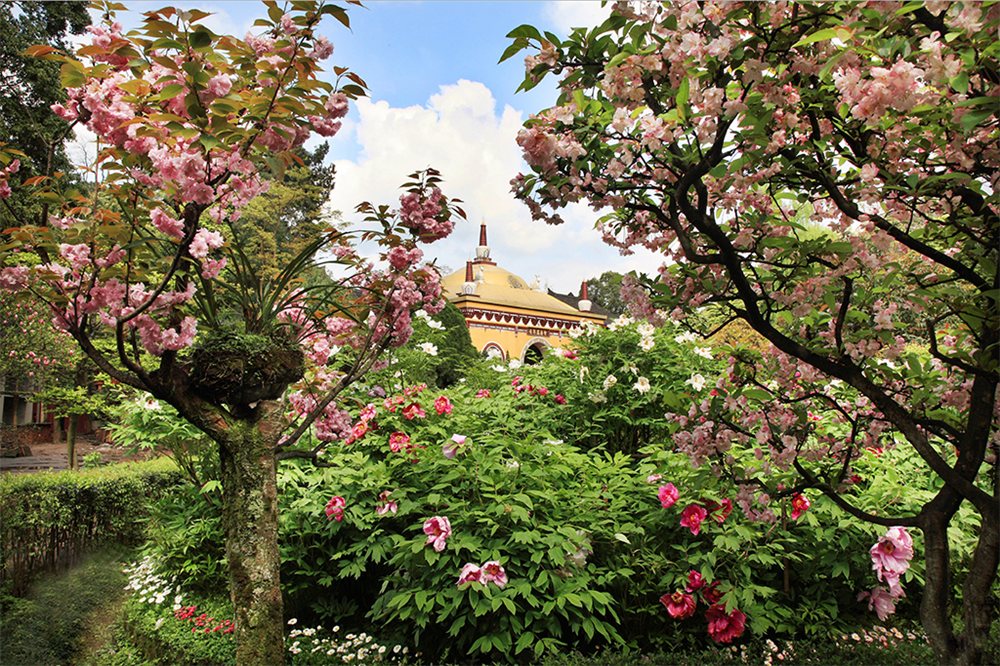The Buddhist Universe
The Buddhist universe is the Buddhism’s explanation of the organization of the universe. All sub-universes are in the same form. Surrounded by the sea the Sumeru Mountain is standing tall and upright above the earth layer in the center. Under the earth layer is the gold layer, and then the fire layer, while wind layer is further beneath. Outside the wind layer is emptiness. The Sumeru Mountain is broad at both ends and narrow in the middle. The sun and moon are at the mountain side. Jambudvipa is around all sides of the mountain. Purvavideha is over the mountain top. Further above are the six heavens of desire. Above them are the 18 heavens of the form realm and four heavens of the formless realm.The Sumeru Mountain is surrounded by seven golden mountains and seven fragrant oceans. There is a mountain between every two oceans. Outside the seventh golden mountain is a salt sea, and a grand iron mountain is further outside. There are four continents surrounding the salt sea. They are Jambudvipa, Purvavideha, Aparagodaniya and Uttarakuru, also known as four continents under heaven. Each continent has two intermediate-continents and hundreds of small continents depending on it. These nine mountains, eight seas, one sun, one moon, four continents and six heavens of desire covered by three heavens of the Pathamam Jhanam are called a small universe. One thousand such universes covered by three heavens of Dutiya Jhana make up a tertiary universe. One thousand tertiary universes covered by three heavens of Tatiya Jhana make up a secondary universe. And one thousand secondary universes covered by nine heavens of Catuttha Jhana and four empty heavens make up a Buddhist universe. Since it has three one thousand folds, the Buddhist universe is also called third-power-of-one-thousand universe.
Buddhist scriptures describe the “Buddhist Universe” in this way:
One sun and one moon make a small universe, with a Sumeru Mountain in the center. That is to say every Sumeru Mountain makes a small universe.
The scope of a small universe is defined by one sun and one moon. Here it probably refers to a solar or stellar system, because every fixed star has multiple satellites. Fixed stars are suns and satellites are moons. For the sun, the moon is always moon. The nine big planets are satellites and “moons”. One thousand small universes add up to one tertiary universe. The scope of each small universe in a tertiary universe is a Brahmafrom Sumeru Mountain to form realm. One thousand tertiary universes make up a secondary universe. Each secondary universe reaches Brahma-parisadya-deva of form realm. One thousand secondary universes make up a Buddhist universe. Each Buddhist universe reaches Brahma of form realm.The Buddhist universe is made of 1,000 secondary universes, each of which is made of 1,000 tertiary universes and 1,000,000 small universes. Therefore, the so-called third-power-of-one-thousand universe is one Buddhist universe. The ruler of the Buddhist world is Mahabrahmaof Akanistha. Every Buddhist universe has a Mahabrahma. Since there are countless Buddhist universes, there are also countless Mahabrahmas. The Buddhist universe we reside in is generally named the Saha World. Each Buddhist universe is a sublimation domain of a Buddha, which is why Sakya is called the hierarch of the Saha World. Earth, our habitat, is but a small unit of the Buddhist universe. In order to completely generalize his sublimation domain, Sakya needs billions of incarnations. Even though there are billions of incarnations, they are all in one Buddhist universe in the Saha World. This indicates the vastness of the Buddhist Cosmology and its similarity to modern astronomy.

